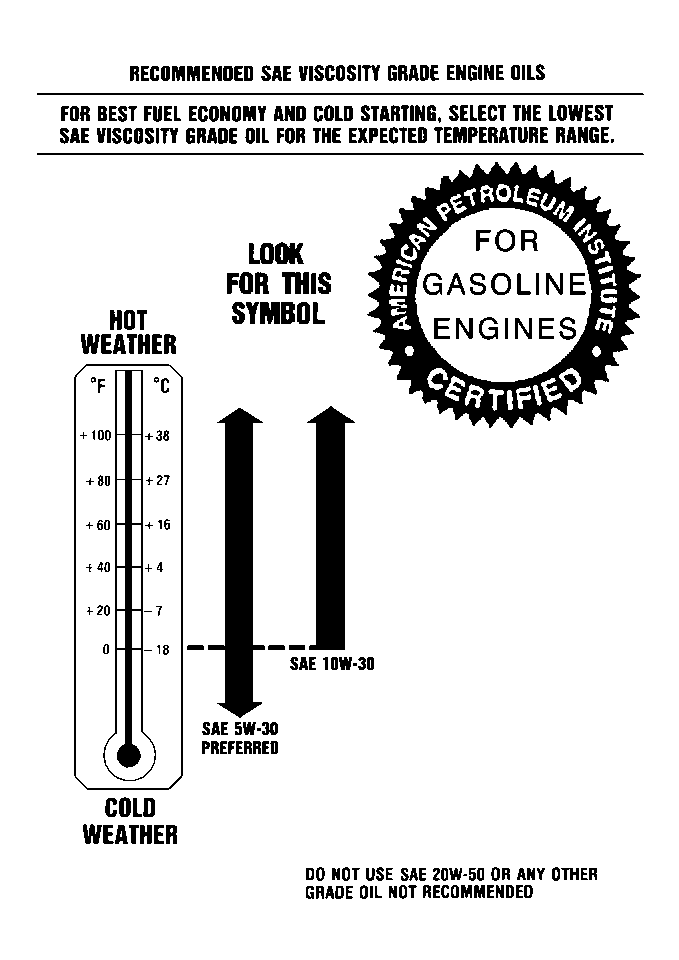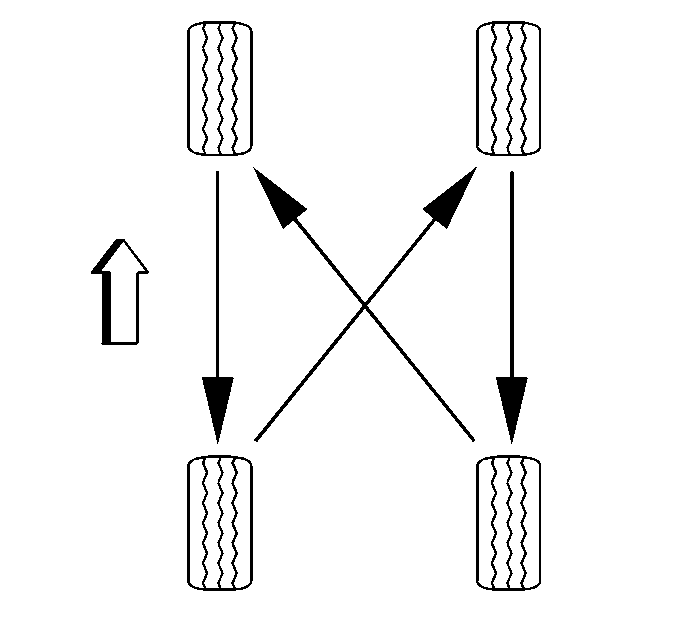Draining and Refilling Engine Oil
Important: When changing the oil on vehicles equipped with L61 engine, remove the oil fill cap and/or the oil filter cap prior to removing the oil pan drain plug.
Keeping the caps in place may create a vacuum effect that can slow the draining process. Allow sufficient time for thorough draining of the engine oil.
Engine Oil and Oil Filter Change
Replace the engine oil and the engine oil filter.
Engine Oil Quality

Oils of the proper quality for the vehicle can be identified by looking for the Starburst symbol. The Starburst symbol indicates that the oil has been certified by the American Petroleum Institute (API), and is preferred for use in gasoline engines.
Engine Oil Viscosity
SAE 5W-30 is the only viscosity grade recommended for your vehicle.
Notice: Using oils of any viscosity other than those recommended could result in engine damage. When choosing an oil, consider the range of temperatures the vehicle will be operated in before the next oil change. Then, select the recommended oil viscosity.
Use only oils which have the API Starburst symbol and which are also identified as SAE 5W-30.
If the temperature range is 0°F (-18°C) or above SAE 10W-30 oil which has the API Starbust symbol is acceptable if SAE 5W 30 oils is not available. Areas where the temperature falls below -20°F (-29°C), it is recommended either an SAE 5W-30 synthetic oil or and SAE 0W-30 oil. Both will provide easier cold starting and better protection for the engine at extremely low temperatures. Do not use other viscosity grade oils, such as SAE 10W-40 or SAE 20W-50 under any conditions.
Oil Filter
Remove the old filter by turning counterclockwise. Clean the gasket sealing area on the engine oil filter mounting surface. If the engine has an adapter base, make sure threaded nipple or bolt is properly tightened. Lightly oil gasket with clean oil and install filter. After the oil filter gasket contacts the oil filter mounting surface, tighten 3/4 to 1 full turn. When necessary, use a cap type wrench, AC Delco OF17W or equivalent or strap type wrench with swivel handle to insure proper installation. With engine oil level at proper level, run engine 3 minutes and thoroughly check filter area for leaks.
Tire and Wheel Inspection and Rotation
Rotate the tires to equalize the wear and obtain maximum tire life. Refer to Tire Rotation in Tires and Wheels.
Check the tires for abnormal wear or damage. If irregular or premature tire wear exists, refer to Tire Diagnosis - Irregular or Premature Wear in Tires and Wheels.

Brake System Inspection
Inspect brake lines and hoses for proper hook-up binding, leaks, cracks or chafing. Inspect disc brake pads for wear. Refer to Brake Pad Inspection in Disc Brakes. Inspect the rotors for poor surface condition. Inspect other brake system components, including brake calipers and the parking brake. Check the parking brake adjustment. The brakes may need to be inspected more often if the customer's driving habits or conditions result in frequent braking.
Air Cleaner Filter Inspection and Replacement
Inspect the air cleaner filter every 25 000 km (15,000 mi) if driving in dusty conditions. Replace if necessary. Replace the air cleaner filter every 50 000 km (30,000 mi). Replace more often under dusty conditions. Refer to Air Cleaner Element Replacement in Engine Controls.
Automatic Transaxle Service
Change the transaxle fluid and the transaxle fluid filter. Refer to Transmission Fluid Replacement in Automatic Transaxle - AF23-5.
Drive Belt Inspection
Inspect the engine accessory drive belt and coolant hoses every 12 months or 18,000 miles (30 000 km), whichever comes first for:
| • | Cracks |
| • | Fraying |
| • | Wear |
| • | Proper belt tension |
| Belts can have small cracks in individual ribs without affecting performance. Refer to Drive Belt Replacement in Engine Mechanical. |
Cooling System Service
Drain, flush and refill the cooling system with new coolant. Refer to Cooling System Draining and Filling in Engine Cooling.
Spark Plug Wire Inspection
Clean the spark plug wires and inspect for burns, cracks or other damage. Ensure that the fit between the spark plug wire boots at the spark plugs and at the coils is snug. Replace the spark plug wires as needed. Refer to Spark Plug Inspection in Engine Controls.
Spark Plug Replacement
Replace the spark plugs. Refer to Spark Plug Replacement Engine Controls.
